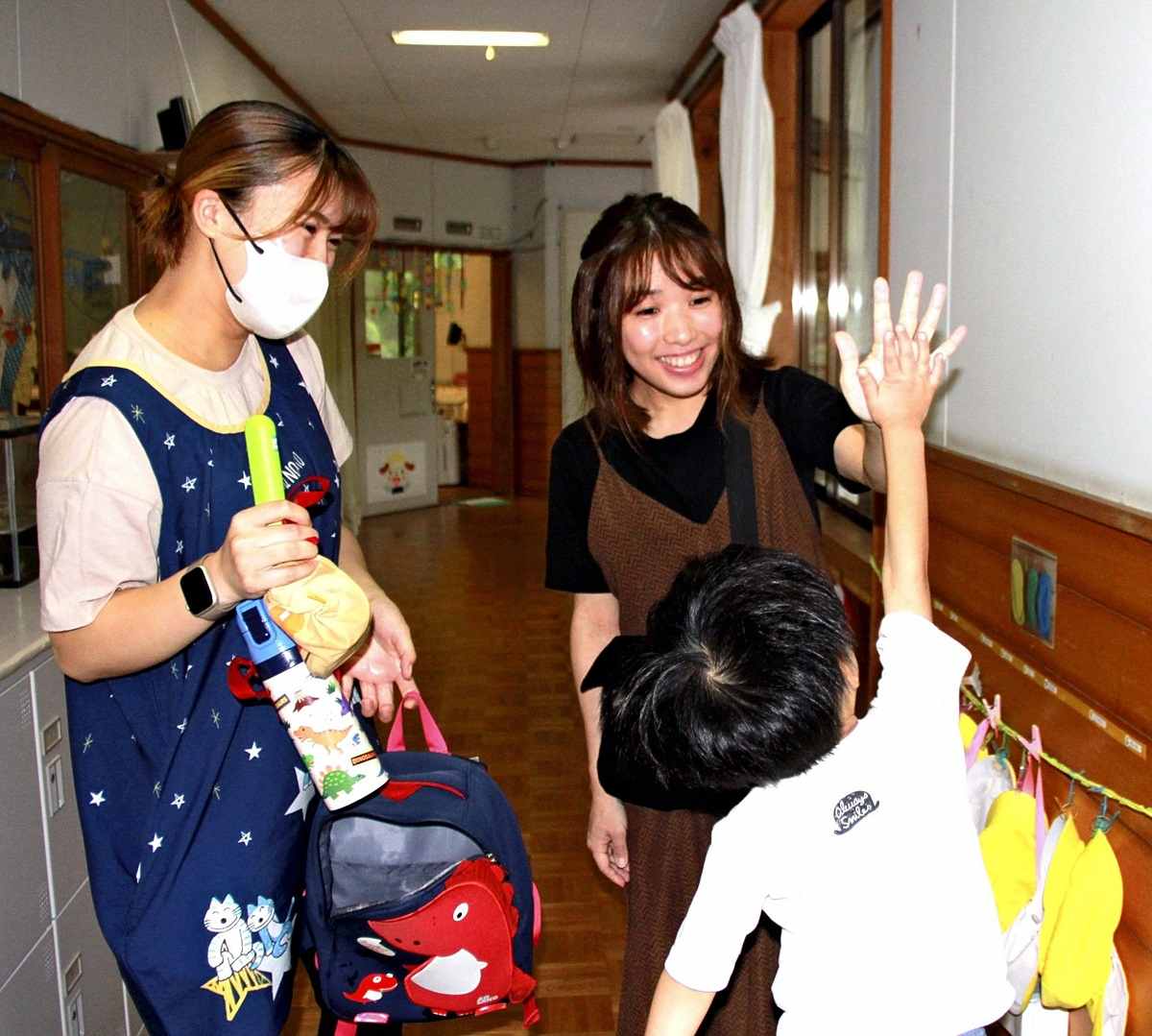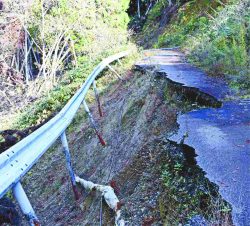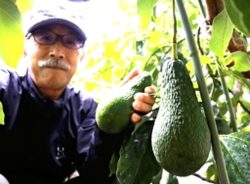
Yuki Numata, right, drops off her son at a nursery school in Sado, Niigata Prefecture, in September.
14:12 JST, December 3, 2023
A new educational program is spreading in which preschoolers are enrolled in day care facilities in rural areas rich in nature for a short-term stay to enjoy life there with their parents. The local governments involved are hoping for positive economic effects and eventually obtaining new residents via the program to help ease declining populations.
From Yokohama to Sado Island
In September, Yuki Numata, 34, and her son, 4, arrived on Sado Island in Niigata Prefecture. The island, which prospered in the past due to its gold mines, has a population of slightly more than 50,000, a decline of about 40% from its peak.
They live in Yokohama, about 300 kilometers from the island. The boy usually attends a nursery school near their home. He was enrolled in a nursery school on the island for two weeks from mid-September.
Together with his classmates, the boy enjoyed catching mantises and crickets, critters he rarely sees in Yokohama.
“I hope he will experience various things he wouldn’t be able to do in his normal life,” Numata, said.
She and her husband, 37, stayed in minpaku private accommodations and worked remotely from their workplaces.
The educational program was started in November 2021 in the town of Assabu, Hokkaido, by KitchHike Inc., a Tokyo-based company that conducts regional revitalization projects.
A stay lasts from one to three weeks and costs several hundred thousand yen, including housing, transportation, and food. Although pricey, the program has been introduced in 38 locations in 19 regions in only two years, attracting 400 families, including repeaters.
Some preschool facilities involved offer special features such as English-language education, as provided in Ueda, Nagano Prefecture, and support for children with developmental difficulties provided in Otaru, Hokkaido.
Decision to migrate
The program is also a vehicle for local governments to encourage people to migrate to their areas.
Facilities for children and their families are prepared at the destinations. During their stays, the children can experience new things and do various activities, while their parents can experience living in the area for a short time.
Many areas hosting the programs are depopulated, and their local governments are hoping for economic benefits. They also want to see the short stays turn into migration to their areas.
“Our ultimate goal is attracting new residents,” said Takayuki Nishimaki, 47, who is in charge of the program at the Sado municipal government.
The program has already been successful in this respect.
Tomomi Endo, 38, and her son, Ko, 6, migrated to Assabu in June from Shinagawa Ward, Tokyo, after getting her employer’s permission to work remotely. Before that, they participated in the program in March.
“Seeing my son playing freely in the spacious nursery school, I decided to move to the town,” Endo said. Several other families are also interested in migrating there.
Employment an issue
It is said that local governments started making efforts to attract new residents after 1970, the year the law concerning emergency measures for depopulated areas was enacted. It was followed by taking measures such as starting the system of local vitalization cooperatives, called Chiikiokoshi Kyoryoku-tai, in various regions.
In 2013-14, the so-called Masuda Report was released by former Internal Affairs and Communications Minister Hiroya Masuda and others warning about the declining population. The report included shocking phrases such as “municipalities with a high risk of disappearing entirely,” which caught the public’s attention, and the government began to focus seriously on regional development.
“In rural areas, more people are leaving than moving in,” said Takumi Fujinami, 58, a senior researcher at The Japan Research Institute. “People moved to regional areas during the COVID-19 pandemic to work remotely, but they did not settle there and have been returning to workplaces in urban areas.”
“To increase new residents in regional areas, employing them locally is indispensable,” Fujinami added.
Fujinami raised his two young children in Kofu after transferring there about 20 years ago.
“Raising children in rural areas has many positive aspects as children can have valuable experiences there,” Fujinami said. “Local governments can also expect to have more short-term visitors and increase local consumption by them.”
Many who participate in the program are repeaters, and preschoolers may build new relationships in urban and rural areas.
Revival of temporary studies in rural areas
Educational programs for children to live and study in areas other than where they live stemmed from a program of living and studying in mountain and fishing villages.
At one time, the village program had fewer users mainly due to the aging of host families. In recent years, thanks to the spread of teleworking among other factors, the number of users started to increase again.
The village program targets elementary and junior high school students. They live in mountain and fishing villages rich in nature and go to local schools for about one year.
According to Zenkoku Sanson Ryugaku Kyokai, a Tokyo-based nonprofit organization promoting the village program, it started in Yasaka, now part of Omachi, in Nagano Prefecture in 1976.
The village program spread nationwide, and 860 people participated in it at its peak in fiscal 2004. The number dropped to 479 in fiscal 2015 because accepting such students became difficult in more municipalities as homestay families got older and schools were closed or consolidated.
The village program was in jeopardy at one time, but seems to have been recovering in recent years thanks to the increased introduction of the variation in which both children and their parents migrate amid the spread of teleworking and other factors in an increasing number of locations.
The advantages of the variation are that there is no need to secure host families and guest families with preschool siblings can live together.
“To continue the program in various regions, it’s important to create a convenient system for people who want to participate,” said Masamitsu Akiyama, 52, a member of the nonprofit organization.
"Society" POPULAR ARTICLE
-

M4.9 Earthquake Hits Tokyo, Neighboring Prefectures
-

Israeli Tourists Refused Accommodation at Hotel in Japan’s Nagano Pref., Prompting Protest by Israeli Embassy and Probe by Prefecture
-

M7.5 Earthquake Hits Northern Japan; Tsunami Waves Observed in Hokkaido, Aomori and Iwate Prefectures
-

Tsukiji Market Urges Tourists to Avoid Visiting in Year-End
-

M5.7 Earthquake Hits Japan’s Kumamoto Pref., Measuring Upper 5 Intensity, No Tsunami Expected
JN ACCESS RANKING
-

Tokyo Economic Security Forum to Hold Inaugural Meeting Amid Tense Global Environment
-

Keidanren Chairman Yoshinobu Tsutsui Visits Kashiwazaki-Kariwa Nuclear Power Plant; Inspects New Emergency Safety System
-

Imports of Rare Earths from China Facing Delays, May Be Caused by Deterioration of Japan-China Relations
-

University of Tokyo Professor Discusses Japanese Economic Security in Interview Ahead of Forum
-

Japan Pulls out of Vietnam Nuclear Project, Complicating Hanoi’s Power Plans























